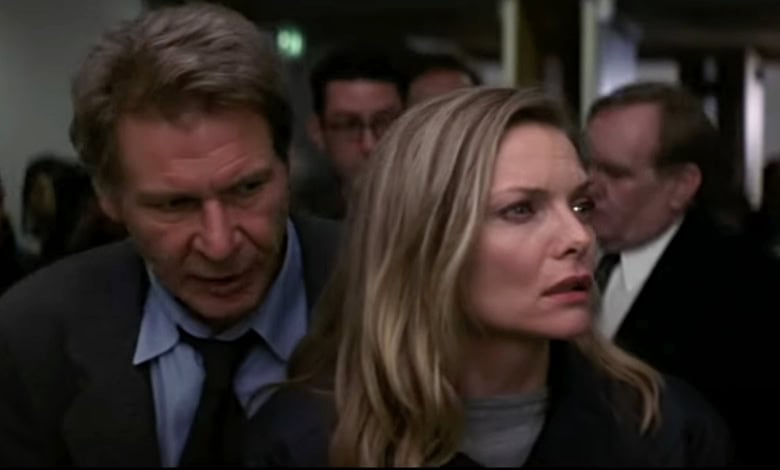
Robert Zemeckis’ “What Lies Beneath” was made before he immersed himself deeply (perhaps too deeply) into CGI overload and was still making films about people faced with unfathomable personal obstacles.
I don’t mean that to sound like sour grapes, only that Zemeckis’ current work feels like an off period (more on that later), whereas movies he made decades ago are among the very best of the post- “Jaws” (1975) late-20th-century-through-today model of blockbuster filmmaking.
Norman (Harrison Ford) and Claire (Michelle Pfeiffer) find themselves empty nesters for the first time, as their daughter heads off to college and leaves them alone in their scenic, lakeside home. That allows them to rekindle their sex life and enjoy solitude, until Claire begins to suspect something questionable is going on with their neighbors (James Remar and Miranda Otto, both wonderful).
Claire’s mounting suspicion unsettles her husband, who fears she may be losing her mind. Even worse, Claire believes that her house is haunted.
Zemeckis kicked off the 21st century with two movies that were made in an unusual, dynamic fashion:
Zemeckis famously shut down production of “Cast Away” (also 2000) for a few months, in order for Tom Hanks to lose weight, grow a beard and become a plausible islander. During the hiatus, Zemeckis made “What Lies Beneath.”
I liked “Cast Away” (despite the non-island scenes seeming so unnecessary and routine in comparison with the quiet, tropical portion of the film), but I’ve always preferred the pulpy thrills of “What Lies Beneath” more.
While rarely mentioned in the same group of film artists who push f/x boundaries as James Cameron and Peter Jackson, Zemeckis deserves to be. His choices as a filmmaker involve material that is difficult to adapt to the screen and he creates the technology needed to make the impossible possible.
In addition to his gift for directing his f/x crew, Zemeckis has always had a strength for bringing out great, surprising work from actors and making even bubble gum films have an edge and playfulness in their design.
Twenty-five years since its release, I was surprised to see that the screenplay is by “Marvel’s Agents of S.H.I.E.L.D.” star Clark Gregg, and that the film not only holds up but is even darker, and richer than I remembered. Many will recall that the film’s studio was criticized for releasing a trailer that gave away far too much of the twisty, surprise-filled plot.
Since the film was a massive hit anyway, no one seemed to have cared about this oversight, as the too-much, too-soon approach to film marketing has hindered many films subsequently.
Here is the rare movie star vehicle that demands real acting, not mere star posing, from its leads. Pfeiffer is solid, making her potentially hysterical character sympathetic and layered, but it’s Ford’s movie. This is a side to the actor rarely tapped into, in a turn that is underrated and among his best.
Seeing the film more than once, there’s a depth and consistent darkness to his tortured character.
Clark’s screenplay is full of Alfred Hitchcock references, visually and thematically, as there’s lots of nods to “Psycho” (1960) and “Rear Window” (1954) though there’s also a little “Ghost Story” (1981), “The Shining” (1980) and “Diabolique” (both versions), too.
Zemeckis has created as meticulously designed a Hitchcock tribute as the best of De Palma. It’s also not without its flaws: at 130 minutes, it’s overlong and has an extended finale that it doesn’t need.
What Lies Beneath (2000) – Directed by Robert Zemeckis pic.twitter.com/7A7NPGZn1k
— Pasquale Marco Veltri (@PMVeltri) January 10, 2024
While the over-the-top climactic scenes don’t derail into CGI oblivion, like the remake of “The Haunting” (1999), they comes close. Alan Silvestri’s great score, unfortunately, has some heavy-handed nods to Bernard Herrmann, which seems pointless (as if we needed reminding that this is a homage to The Master of Suspense).
What unquestionably works is the bathtub sequence near the end, where a character finds their tub is no longer a place of tranquility. This masterful set piece, utilizing top-notch editing, sound and cleverly positioned camera angles, puts us in the same terrifying position as the protagonist.
“What Lies Beneath” (1981) may lack Wilson the Volleyball, but it serves up big scares and an unsettling theme of questioning everything you think you know about your spouse. This would make a devious double feature with “Gone Girl” (2014).
The last time Zemeckis made a film I loved this much, it was “Flight” (2012). I admittedly watch “The Polar Express” (2004) every December and dug the pulpy thrills of the 2007 “Beowulf” in IMAX 3-D (loved seeing it that way, haven’t seen it since), but I’ve been a grumpy fan since.
His last trio of movies that drowned bad screenplays with oodles of busy special effects were “The Witches” (2020), “Pinocchio” (2022) and “Here” (2024), all of which are so awful, they feel like self-parody.
The Zemeckis of my youth used special effects as a storytelling tool, whereas the Zemeckis of today seems a prisoner to the pixels he helped usher in. That sucks. I love most of his movies, but can’t help but wonder if he’s lost his way. I’m looking forward to a comeback that I suspect will arrive at some point.
For now, I turn to “What Lies Beneath” for the kind of lavish blockbuster that Hitchcock might have made and most certainly would have enjoyed.
